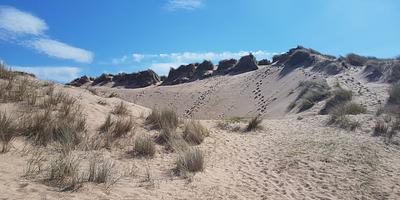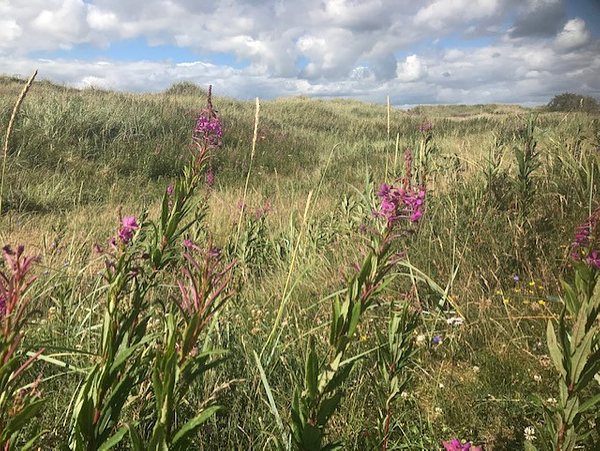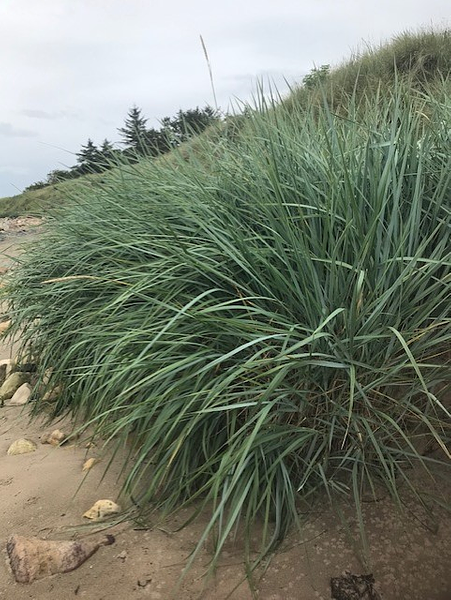
SAND DUNES
Sand dunes are undulating mounds of sand formed and colonised by specially adapted plants.
These dramatic habitats change from bare sand at the back of sandy beaches to woodlands found miles inland.
Incredibly, if conditions are right, sand dunes can grow to heights of 100m!
Scotland has 50,000 hectares of sand dunes, representing over 70% of Great Britain’s coastal sand resource, but are at risk from a variety of threats. Loss of sand dunes results in the loss of specially adapted sand-dwelling species, some of which are only found in this habitat.
FORMATION
Dunes are at different stages of their development. Look across a dune system and you’ll notice dunes change in size, composition and inhabitants.
Sand dunes form when sand blown from beaches gets trapped amongst objects at the back of the shore and gradually builds up above sea level.
These small mounds of sand, called 'foredunes', consist of unstable, dry, nutrient-deficient and salty conditions where only the hardiest ‘pioneer species’ can grow (plant species that are first to colonise bare ground). Once established, pioneer species stabilise the sand and add organic material when they die, making conditions more favourable for other, larger plants to grow.
The addition of these species marks the transition of foredunes to 'mobile dunes'. As hinted at by their name, these dunes are held together by the plants but continue to shift with the wind.
'Fixed dunes' occur where the sand has become stabilised by the vegetation.
Though the dunes themselves become fixed, conditions within the stage can still change. Dune 'slacks’ occur amongst the dunes - areas of bare sand where erosion and strong winds have taken the sand back below the level of the water table.

As the number of species increases, the availability of space and resources decreases and species have to compete for a place on the dune. Eventually the area is taken over by dominant species which are able to outcompete the others. This final stage of a sand dune system is called the ‘climax community’, and appears as deciduous woodland in the UK.
The change of community like this over time is called ‘succession’. One stage will always be replaced by the next as long as conditions are changing. Climax communities are the final stage because the habitat has reached ‘equilibrium’ - balanced conditions where no new species move into the area.
If undisturbed, new mobile dunes will form at the front of the dune system and the whole process will start again. Looking from one end of the habitat to the other is therefore like looking over the stages of a sand dune’s life - new dunes appear close to the shore whilst older dunes are found at the back.
The formation of new dunes results in the habitat slowly but surely encroaching into the sea.
INHABITANTS
Pioneer species such sand couch (Elytrigia juncea), sea rocket (Cakile maritima) and orache (Atriplex spp.) are the first plants to grow in dune systems, colonising bare sand at the back of sandy shores. Pioneer species are able to live in these dry, unstable and salty conditions because of special adaptations that help them survive. Adaptations include thick outer layers and succulent leaves that protect them from sand scour and water loss.

Lyme grass (Leymus arenariusm) and marram grass (Ammophila arenaria) are characteristic mobile dune builders. Marram grass has special adaptations such as roots, rhizomes (horizontal stems) and shoots that bind the sand, and rolled-up, waxy-coated leaves to prevent water loss. Both these species play a vital role in stabilising dunes so other species can grow, including sea spurge (Euphorbia paralias), viper’s bugloss (Echium vulgare) and sea bindweed (Calystegia soldanella).
Different species are adapted to different conditions within the dune system. For example, creeping willow (Salix repens) is only found in dune slacks.
Once dunes become fixed they support a wider variety of plants. Where there’s little seashell in the sand, dunes develop acidic soils that support heathland and lichen-rich communities. On more alkaline systems, dune grassland becomes the dominant community.
Eventually, woody plants such as brambles, sea buckthorn (Hippophae rhamnoides) and small trees such as young birch move in to form a dune scrub in the later stages of the dune system.
As the density and variety of plants goes up, so does the abundance of invertebrates. Species to look out for amongst UK sand dunes include the grayling butterfly (Hipparchia semele), grey bush-cricket (Platycleis albopunctata), jumping spider (Sitticus distinguendus), green tiger beetle (Cicindela campestris) and sand wasp (Ammophila sabulosa).
The abundance of insects provides food for small land mammals living amongst the vegetation which, in turn, attract birds of prey such as kestrels (Falco tinnunculus) and short-eared owls (Asio flammeus).
Once stabilised, dunes can also support a variety of ground-nesting birds such as ringed plover (Charadrius hiaticula) and tern species.
LOCALISED THREATS
In addition to the large-scale threats facing the marine environment, sand dunes are at risk from the following:
- Land reclamation and urban development – large areas, especially the later stages, are often cleared to make way for new housing or industry.
- Non-native species – Pirri-pirri bur (Aceana novae-zelandiae) is a plant native to New Zealand and Australia that has been introduced to UK shores. This plant is able to rapidly spread throughout dune systems due to its spiney fruiting heads and outcompete the native species that live there. Find out more here:
- Human activities – Sand dunes are popular places to build golf courses. In these locations a ‘plagio climax’ occurs whereby succession is halted and is never allowed to reach its highly productive and environmentally important climax community. Trampling also wears away the vegetation and erodes the dunes.
- Afforestation - 6,000 hectares of Scotland’s sand dunes have been converted to conifer plantation.
